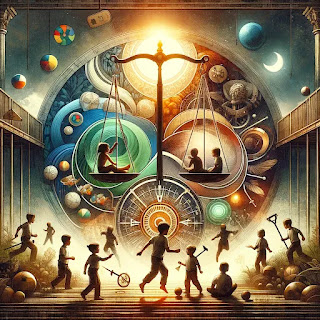Part 8: The Influence of Play Contexts: Exploring Cultural Dimensions of Morality
Beyond Borders: Cultural Narratives in Play and Their
Impact on Moral Development
In our ongoing exploration of the intricate relationship
between play and morality, we now turn our gaze to the profound influence of
cultural contexts. Play, a universal human activity, takes on unique shades of
meaning within different cultural landscapes. This segment delves into how
cultural narratives embedded in play contribute to the shaping of moral values,
ethical perspectives, and the development of a culturally nuanced moral
compass.
Cultural Dimensions of Play: A Mosaic of Morality
Before delving into the interplay between play and cultural
morality, let's unravel the concept of cultural dimensions.
Cultural Dimensions Defined:
Cultural dimensions encompass the shared values, beliefs,
customs, and social practices that characterize a particular group or
community. These dimensions provide a lens through which individuals interpret
the world and navigate their social and moral landscapes.
Moral Significance of Cultural Dimensions:
Influence on Ethical Frameworks: Cultural dimensions play a
pivotal role in shaping ethical frameworks. They contribute to the definition
of what is considered moral or ethical within a specific cultural context.
Cultural Relativism: Cultural dimensions also give rise to
the concept of cultural relativism, suggesting that moral and ethical values
are relative to the cultural context in which they are embedded.
Play as a Cultural Mirror: Reflecting Morality Through
Narratives
Now, let's explore how play becomes a mirror reflecting and
transmitting cultural narratives of morality.
Imaginative Play and Cultural Narratives:
Role of Storytelling: Imaginative play often involves
storytelling, where narratives are created and shared. These narratives carry
cultural nuances, including moral values, societal norms, and ethical lessons.
Symbolic Representation: Play activities frequently include
symbolic representation, such as using toys, props, or costumes. These symbols
often carry cultural significance and contribute to the transmission of moral
values.
Role-Playing and Cultural Identity:
Cultural Characters: Role-playing within the context of
play often involves embodying cultural characters or archetypes. This immersion
contributes to the reinforcement of cultural identity and the transmission of
associated moral values.
Cultural Scenarios: Play scenarios may mirror real-life
cultural situations, allowing individuals to explore and make ethical decisions
within the cultural context presented in the imaginative realm.
Cultural Relativism in Play: Understanding Diverse
Perspectives
Cultural relativism, a key concept in cultural
anthropology, comes to life within the realm of play.
Flexible Rule Structures:
Negotiation of Cultural Norms: Play involves the
negotiation of rules, and in the context of cultural dimensions, this
negotiation extends to the interpretation of cultural norms. Children, through
play, engage in a dynamic process of understanding and negotiating cultural
expectations.
Cultural Sensitivity: Play allows individuals to develop
cultural sensitivity by navigating the complexities of diverse cultural norms
and values. This sensitivity becomes a foundation for respecting and
understanding different moral perspectives.
Practical Implications: Fostering Cultural Awareness
Through Play
Understanding the influence of cultural contexts on play
opens avenues for practical strategies to foster cultural awareness and
sensitivity.
Introduce Diverse Play Materials:
Culturally Representative Toys: Provide toys, books, and
play materials that represent diverse cultures. This exposure encourages
children to explore and appreciate cultural differences from a young age.
Multicultural Art Supplies: Include art supplies that allow
for the exploration of diverse cultural art forms. This not only promotes
creativity but also introduces children to the richness of cultural
expressions.
Celebrate Cultural Festivals:
Incorporate Festive Play: Introduce play activities that
celebrate cultural festivals and traditions. This not only educates children
about diverse cultural practices but also allows them to engage in the joyous
spirit of cultural celebrations.
Storytelling from Different Cultures: Encourage
storytelling that includes narratives from various cultural backgrounds. This
not only expands children's literary horizons but also exposes them to
different moral perspectives embedded in cultural stories.
Promote Inclusive Play Settings:
Diverse Playgroups: Facilitate playgroups that bring
together children from various cultural backgrounds. Inclusive play settings
provide opportunities for cultural exchange, fostering understanding and
friendship.
Cross-Cultural Collaborations: Encourage collaborative
projects that involve children in creating play scenarios that integrate
elements from different cultures. This collaborative approach promotes teamwork
and cultural appreciation.
The Role of Play in Cultural Moral Education: Nurturing
Informed Global Citizens
As we consider the influence of cultural contexts on play,
it becomes apparent that play serves as a powerful tool for cultural moral
education.
Cultivation of Cultural Competence:
Understanding Cultural Nuances: Play allows individuals to
immerse themselves in cultural nuances, promoting an understanding of the
complexities of different cultural perspectives.
Cultural Communication Skills: Through play, children
develop communication skills that transcend cultural boundaries. The ability to
negotiate and share ideas within diverse play settings contributes to cultural
competence.
Formation of Informed Global Citizens:
Cultural Awareness: Play contributes to the development of
cultural awareness, an essential component of global citizenship. Informed
global citizens are those who can navigate and appreciate cultural diversity.
Ethical Decision-Making on a Global Scale: Play scenarios
that incorporate cultural dimensions provide a foundation for ethical
decision-making on a global scale. Individuals exposed to diverse cultural
narratives within play settings are better equipped to make informed and
culturally sensitive choices.
Conclusion: Play as a Bridge Between Cultures and Morality
As we navigate the intricate interplay between play,
cultural dimensions, and morality, it becomes evident that play is not only a
reflection of cultural narratives but also a bridge that connects individuals
across diverse cultural landscapes. The cultural dimensions embedded in play
contribute to the development of moral values, ethical perspectives, and a rich
tapestry of cultural understanding. In the upcoming segments of this series, we
will continue our exploration, delving into play-based approaches to moral
education and the lifelong impact of play on moral development. Stay tuned as
we unravel more layers of this fascinating journey where play and culture
converge to shape the moral fabric of individuals and societies.

Comments
Post a Comment